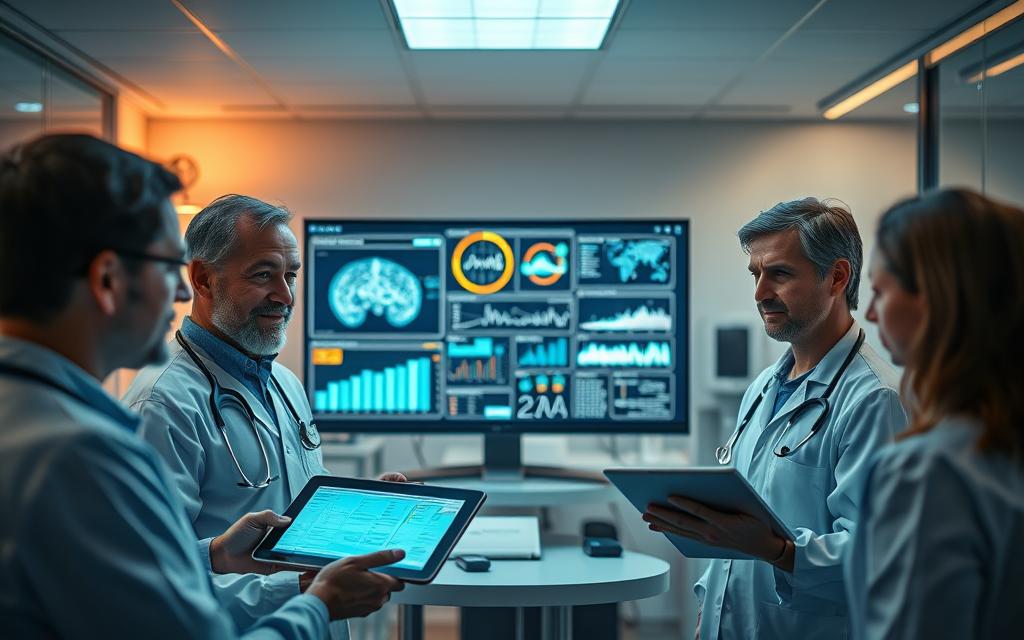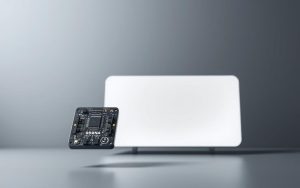Modern medicine is at a thrilling point. Digital health solutions are changing how we care for patients. These changes are more than just new tools and apps. They are changing healthcare itself.
Deloitte’s Centre for Health Solutions says these new ways break old rules. They open up new possibilities in treating and diagnosing diseases.
The main idea is to get more value with fewer resources. Patients get better results and easier access to care. Doctors and hospitals also see less complexity and more efficiency.
This shift marks a big change in healthcare technology advancements. It’s moving us towards smarter, more effective medical systems. These systems will benefit everyone.
Defining Health Technology: What Is a Health Technology?
Health technology combines medical science with digital innovation. It creates systems that change patient care. This field includes simple tools and complex artificial intelligence platforms.
Modern health technologies link old medical ways with new digital ones. They help doctors give better, more precise care. This change is big in how we treat and prevent illnesses.
The Historical Evolution of Medical Technologies
Medical technology started with simple tools like stethoscopes and thermometers. These tools were the start of diagnostic medicine. The 20th century brought big changes with X-rays and electronic devices.
The digital age really sped up medical tech’s growth. Computers changed how we manage data, and smaller devices made care portable. This marked a shift from old to new healthcare ways.
Recently, connected health tech has become key. Internet and wireless sensors let us monitor health from afar. This shows how innovation meets clinical needs in medical history.
| Time Period | Key Technologies | Impact on Healthcare |
|---|---|---|
| Pre-20th Century | Basic diagnostic tools | Foundation of clinical examination |
| Early-Mid 20th Century | X-rays, electronic monitors | Advanced diagnostic capabilities |
| Late 20th Century | Digital systems, MRI/CT scanners | Imaging revolution and data digitisation |
| 21st Century | IoT, AI, wearable sensors | Predictive and personalised medicine |
Core Components of Modern Health Technology Systems
Today’s health tech systems have many parts. The hardware includes devices, sensors, and computers. These are the basics of any health tech setup.
Software is another key part. It handles data, analysis, and user interaction. Health software has grown a lot with computer power.
Data management is vital. It stores, processes, and keeps health info safe. Good data management is key for health tech.
Systems must work together smoothly. This is called interoperability. It’s important for caring for patients across different places. The healthcare IT infrastructure must support this while keeping data safe.
The parts of health tech systems work together. They help in monitoring patients and delivering treatments. Knowing these parts helps us see how modern healthcare works.
New technologies are changing medical care even more. AI, IoT, and sensors are leading the way. They build on what we have to make healthcare systems better.
Major Categories of Health Technology Innovations
The world of medical technology has grown a lot. New ideas are changing how we get and manage care. These changes help patients get better and make healthcare work better.
Electronic Health Records and Data Management Systems
EHR systems are key to digital healthcare. They keep patient info in one place. This makes it easy for doctors to see important data anywhere.
Good healthcare data management helps doctors work together better. It cuts down on tests and gives a full medical history for each patient.
Epic Systems and Cerner Solutions
Epic Systems leads in hospital EHRs. Their system links different care areas together. It makes sharing info easy in big healthcare networks.
Cerner Solutions has strong tools for managing health. Their systems help find health trends and manage long-term conditions better.

Telemedicine Platforms and Remote Monitoring
Telemedicine platforms have changed how we get care, even more so during the pandemic. They let patients talk to doctors online.
Remote monitoring lets doctors keep an eye on patients from afar. This helps catch problems early and lowers hospital visits.
Teladoc Health and American Well Services
Teladoc Health offers a wide range of virtual care. They work with devices to monitor patients better.
American Well Services (now Amwell) helps health systems and insurers with telehealth. They offer both scheduled and urgent care visits.
Artificial Intelligence in Diagnostic Imaging
AI diagnostic tools are changing how we read medical images. They use patterns and predictions to spot issues fast and accurately.
AI can find things that humans might miss, like in mammograms or brain scans. This is because it can look at lots of data at once.
IBM Watson Health and Aidoc Analytics
IBM Watson Health made AI for cancer and genetics before focusing on other areas. Their tech helps doctors find the best treatments by looking at lots of studies.
Aidoc Analytics focuses on AI for radiology. They quickly find important issues like strokes. This means doctors can act faster.
Robotic Surgical Systems and Assistance
Robotic surgery technology makes complex surgeries better. It gives doctors a clear view and precise tools. This helps them make smaller cuts and lose less blood.
Doctors control the robots but get better control and vision. This leads to less invasive surgeries and quicker recovery times.
Intuitive Surgical’s da Vinci System
The da Vinci System is a top choice for robotic-assisted surgery. It’s used in many places around the world. It helps with surgeries in different areas.
Doctors use a console to control the robots. This has led to many new ideas in surgery. You can learn more about these advancements at healthcare innovation sites.
Robotic systems have many benefits:
- They offer clear 3D images
- They move in ways humans can’t
- They reduce surgeon fatigue
- Patients recover faster
Benefits and Impacts on Patient Care Delivery
Health technology is changing how we get medical help. It’s making care better and more efficient. These changes help patients get better faster and make healthcare work smoother.
Enhanced Diagnostic Accuracy and Speed
Today’s diagnostic tools use artificial intelligence to look at medical images with great detail. They spot things that humans might miss. This leads to quicker and more accurate diagnoses.
Diagnoses are now much faster thanks to these tools. What used to take days can now be done in hours or even minutes. This means patients can start treatment sooner, which helps them get better faster.
Improved Treatment Personalisation Approaches
Wearable sensors and constant monitoring give doctors real-time health data. This helps create treatment plans that fit each patient’s needs. It takes into account their health, lifestyle, and other important factors.
Special software uses this data to suggest the best treatments. This leads to better results and fewer side effects. It means care is more tailored to each person, not just a general approach.
Increased Accessibility to Specialised Care Services
Telemedicine lets people in remote areas see specialists without leaving home. This breaks down barriers to expert care. It’s a big help for those in rural or hard-to-reach places.
Remote monitoring lets doctors keep an eye on patients with chronic conditions. This helps prevent hospital visits and keeps patients comfortable at home. It’s a win-win for both patients and healthcare providers.
These technologies make healthcare more fair. They ensure everyone gets the quality care they need, no matter where they live. It’s a step towards better healthcare for all.
Implementation Challenges and Practical Considerations
Health technology innovations are promising, but their successful use is not easy. Health tech implementation challenges need careful planning and execution. This ensures the technology works well without upsetting current practices.

Data Security and Patient Privacy Protections
One big worry in digital health is data security in healthcare systems. As health records go digital and connect more, they become more vulnerable to cyber threats.
Healthcare groups must use strong encryption and access controls. They need to keep patient data safe while making sure staff can access it when needed.
Following rules like HIPAA is also a big task. It’s hard to keep up with new security threats while following these rules. Regular checks and updates are needed.
Integration with Existing Healthcare Infrastructure
Many healthcare places find it hard to integrate new tech with old systems. Old systems often can’t talk to new ones easily.
Getting new tech to work with IoT and AI is a big challenge. Without good connections, new tech might not work as well as hoped.
To integrate well, planning is key. Teams must focus on data standards and how systems talk to each other. This ensures new tech works with what’s already there.
Training Requirements and Professional Adoption
Getting staff to use new tech well is another big issue. Healthcare workers need good training on new systems to use them right in patient care.
Not involving doctors in the start can lead to tech not meeting real needs. Working with doctors early helps make sure tech helps, not hinders, care.
Keeping staff up to date with training is vital for success. When staff feel confident and see the value, they’re more open to change.
Creating training that fits different learning styles and levels is important. This helps all staff members get on board with new tech.
Conclusion
Health technology has changed how we get medical care. It includes things like electronic health records and AI for diagnosing. These changes make care more accurate, tailored to each person, and more accessible.
Looking ahead, health tech needs teamwork. Deloitte says we must stay flexible and work together to innovate. Doctors should help guide this change, making sure tech fits with what patients need.
Our outlook on health tech is hopeful but realistic. There are challenges like keeping data safe and integrating systems. But the benefits are worth it. More investment in new tech will lead to better care for everyone.
The path to fully connected health tech systems is ongoing. By embracing new ideas and solving real problems, we can reach our goal. This goal is to improve health outcomes for everyone through smarter care.






